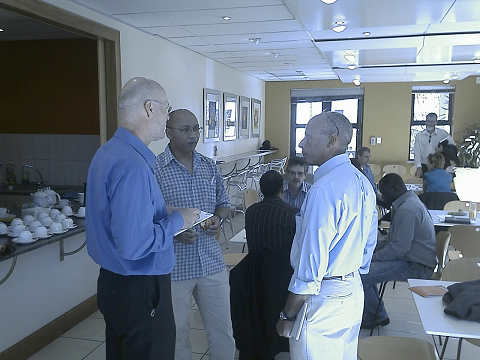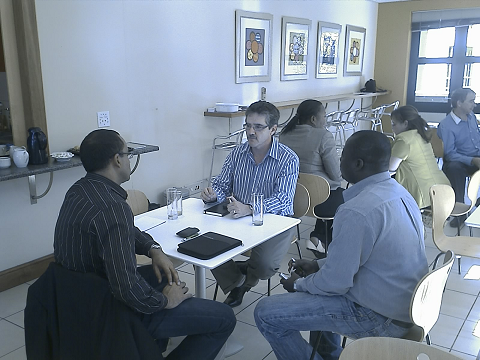By Roderick Lim Banda
www.kase.co.za
The first half of our March Breakfast Forum was spent in the auditorium of the SAP offices at Century City in Cape Town. The venue offered both a conference auditorium for the presentation and the cafe conversations or discussions in the second half.
Ronnie Schmidt of Biamic did a presentation on process automation. He took the CIO Priorities and mapped specific process automation solutions to addressing some of the top CIO priorities for 2009 which was posted on this site from CIOInsight.com. See Topics.
Ronnie's presentation established the context and foundation for our conversation which dealt with human intellectual capital, a topic that was proposed at our January breakfast forum. Our discussion was aimed at visualizing an utopian enterprise which had mature processes and process automation, enabling human intellectual capital to be focused on becoming a learning organization. So what would be the ideal learning organization and what would characterize it? Four groups were formed and were asked to engage in a table conversation for 10-15 minutes after which we had a group discussion and tried to identify a common voice or shared patterns.
Interestingly, the groups emerged with 4 perspectives and focus:
Technology Perspective: Solutions and Systems Integration
From a technology perspective, we see an utopian learning organization reaching a point of Nirvana in terms of how systems should work. We visualized a calmer organization where we spend more time focusing on important things like analyzing problems and finding solutions. There is less reliance on IT. There is a paradigm shift and there are benefits gained from technologies such as virtualization. There is strong collaboration with suppliers and where there is ease in change. We get the latest updates and versions of software from vendors such as SAP, Oracle, Microsoft, etc. There is ease of integration of systems and one version of truth.
Management Perspective: People, Culture and Alignment
We see an organization that is people-centric. The desired and cliched alignment between business and IT exists and there is organizational harmony. Knowledge management exists to overcome the problem of people holding onto their knowledge and being scared to share for fear of losing their jobs. The profile of the type of personality that represents the "glue" between silos is important and is typified by the stereotypical female that is helpful. Women seem to possess an intrinsic quality to be constructive and positive. There is a culture of aligning people and processes. The typical corporate CEO is a dinosaur and there is a greater demand on individuals to think strategically.

Organizational Perspective: Business and Transformation
Business process automation is interpreted here as being about transforming the business. A learning organization is about people. "People putting things in their heads". Delivery is on time and automated and using the example in Ronnie's presentation of value gained from taking a process that took 3-5 hours and reducing that to 3 minutes. And where this causes a reduction in staff by 100 people, we consider moving them or helping them move on rather than "firing" them. In an automated environment, we look at optimization and finding the blockages. Which department represents a bottle-neck? It is also important to consider where we place KM, is it in IT or is there a more appropriate place for it to be championed within the organization.

Social Perspective: Adaptability and Change
What defines the "Perfect World of the Enterprise"? There is adaptability and responsiveness to change in the external and internal environment. There is an open feedback loop. In the lean manufacturing world, there is intensive "face-to-face" interaction. Tools include facebook and social networking. People work from home. They log into the enterprise systems from home and employees are available 24 hours a day. We see a number of examples of electronic interactions but under this is a system of structured and unstructured data. Data and documents are readily available and there is a portal that brings this together.

We also see how the notion of an ideal enterprise can be used in academia by establishing a simulated office environment where students learn instead of spending all their time in lecture halls. They gain both theoretical understanding and practical experience. Accounting students as an example can learn to apply theories on debit and credit in a practical environment where they gain an understanding of business processes.